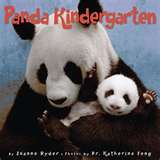 It’s back-to-school time, even for pandas. Joanne Ryder and Dr. Katherine Feng have made the world’s cutest informational book, Panda Kindergarten. The photos of the baby pandas at the Wolong Nature Reserve in China are unbearably adorable. Sixteen roly-poly panda cubs are learning the skills they will need to survive in the wild some day. No math or phonics lessons in this kindergarten class, but lots of social skills are learned as the pandas climb on the wooden structures, tumble in the snow, and even take afternoon naps together.
It’s back-to-school time, even for pandas. Joanne Ryder and Dr. Katherine Feng have made the world’s cutest informational book, Panda Kindergarten. The photos of the baby pandas at the Wolong Nature Reserve in China are unbearably adorable. Sixteen roly-poly panda cubs are learning the skills they will need to survive in the wild some day. No math or phonics lessons in this kindergarten class, but lots of social skills are learned as the pandas climb on the wooden structures, tumble in the snow, and even take afternoon naps together.
One of the Common Core State Standards in reading across all grade levels is “range of reading”. More and more, our students will be expected to read informational text and “show what they know”. One of the best ways you can help students become more fluent informational readers is to surround them with irresistible nonfiction books. Panda Kindergarten is a picture book with simple text and great photos, so it works as well for a read-aloud as any story picture book. After reading this book aloud, and pausing for the inevitable “Awwwww!’ with each photo, read the “fast facts” on the last page. “A newborn giant panda is the size of a stick of butter and weighs about four ounces…. an adult panda can weigh well over 200 pounds.” How much is four ounces? How much is a pound? Make a list of weight predictions: “I think a stapler weighs four ounces.” Bring scales into your classroom. Let students weigh and record a variety of objects to find out what else is about four ounces to get a sense of how small a newborn panda is. Students can also weigh themselves on a scale. How many students would it take to weigh about as much as an adult giant panda?
Students can also compare “panda kindergarten” and kindergarten for humans using a Venn diagram, or by writing and drawing things that are the same and things that are different. Go outside to see if your students can “swing and climb and play with their (new) friends” like panda cubs do!
To find out more about the China Conservation and Research Center for the Giant Panda at the Wolong Nature Preserve, please visit pandasinternational.org.



